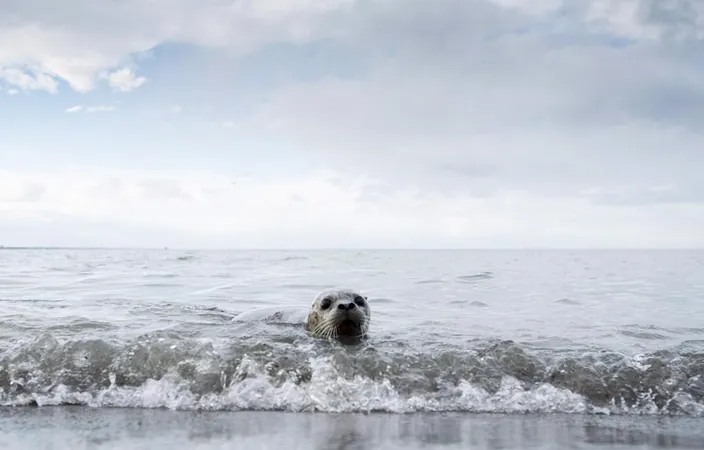
Alarming Spike in Seal Deaths Sparks Warning Over Avian Flu in Quebec
2024-11-24
Author: Emily
Introduction
A troubling investigation has recently surfaced regarding the growing infection of mammal species by avian influenza viruses, signaling potential risks to human health. The rising mortality rates among seals in the St. Lawrence River throughout 2022 have raised red flags about the pathogen's potential for mutation and increased pathogenicity in mammals.
Significant Increase in Seal Deaths
Between April and September of 2022, over 209 dead or sick seals were reported in the estuary and Gulf of the St. Lawrence. This was a staggering increase—nearly four times greater than historical averages—particularly affecting populations of common and gray seals. The H5N1 strain of avian flu has been conclusively linked to several of these deaths.
Transmission Concerns
Research conducted by the Centers for Disease Control and Prevention (CDC) suggests that the presence of numerous bird carcasses infected with H5N1 at seal haul-out sites might have played a significant role in transmitting the virus to these marine mammals. However, investigators are still unable to confirm if the virus was passed from seal to seal. According to Stéphan Lair, co-author of the study, "In the outbreak we saw in 2022, especially among common seals, there seems to be no evidence that the virus was transmitted from one seal to another. The disease was so acute that the animals didn’t have time to excrete the virus extensively."
Global Implications of H5N1
This alarming reality raises deep concerns. In South America, the current H5N1 strain has led to "very significant" deaths among sea lions, amounting to thousands of casualties, indicating that transmission between sea lions did occur due to their closer social contact.
Risks to Public Health
The implications of these findings point to marine mammals potentially serving as reservoirs for the avian flu virus, escalating the risk of mutations that could breach species barriers and infect new mammalian hosts. The CDC report emphasizes the urgent need for monitoring the virus within wild marine mammal populations to evaluate the public health risks associated with this emerging pathogen-host dynamic.
Recent Developments in Quebec
The situation in Quebec has garnered further attention, as the Canadian Food Inspection Agency has reported cases of avian influenza in domestic birds on November 17 and 18 at two separate poultry farms in Montérégie.
Expert Insights and Recommendations
Despite the concerning developments, experts urge calm. Just last week, Canada confirmed its first human case of H5N1 avian flu in British Columbia. According to Lair, a professor at the Faculty of Veterinary Medicine at the University of Montreal, "While we have seen some human cases, they are rare, suggesting that this virus is not well adapted to humans." He highlighted that the circulating strain is distinctly different from previous strains that have caused extensive human cases, which offers some reassurance.
However, experts remain vigilant, given the virus's potential to mutate. Lair noted, "Public health is always a little more concerned when an avian virus starts infecting mammals like seals because it shows that it is adapting to mammalian cells. Are we next on the list?"
Brian Ward, a professor at McGill University and co-director of the Vaccine Study Centre at the MUHC, echoed these concerns, mentioning that while recent infections in sea lions and domestic birds have raised alarms, the history of virus circulation among wild birds is well established, with the risk of mutations making transmission to mammals easier.
Current Situation and Preparedness
Current reports indicate no human-to-human transmission, which Ward believes mitigates some immediate concerns. He highlighted that while transmission in birds typically occurs via the oral-fecal route, aerosol exposure in densely populated areas could lead to infection in seals, among other potential scenarios.
Both experts agree on the need for preparedness as the possibility of an avian flu virus becoming a more significant threat looms. "No need to panic at the moment," Ward stated, "but this situation should motivate us to enhance our defenses against future pandemics, as they are bound to occur."
Conclusion
With ongoing investigations and monitoring, the public health implications of H5N1 and its impact on both wildlife and potential human health must remain a priority for researchers and policymakers alike as we brace for what the future may hold.









 Brasil (PT)
Brasil (PT)
 Canada (EN)
Canada (EN)
 Chile (ES)
Chile (ES)
 España (ES)
España (ES)
 France (FR)
France (FR)
 Hong Kong (EN)
Hong Kong (EN)
 Italia (IT)
Italia (IT)
 日本 (JA)
日本 (JA)
 Magyarország (HU)
Magyarország (HU)
 Norge (NO)
Norge (NO)
 Polska (PL)
Polska (PL)
 Schweiz (DE)
Schweiz (DE)
 Singapore (EN)
Singapore (EN)
 Sverige (SV)
Sverige (SV)
 Suomi (FI)
Suomi (FI)
 Türkiye (TR)
Türkiye (TR)